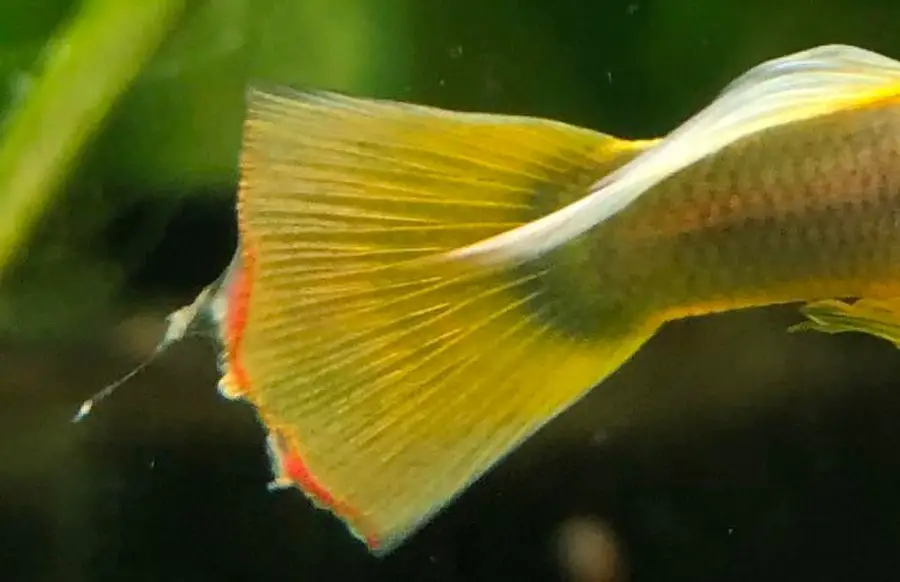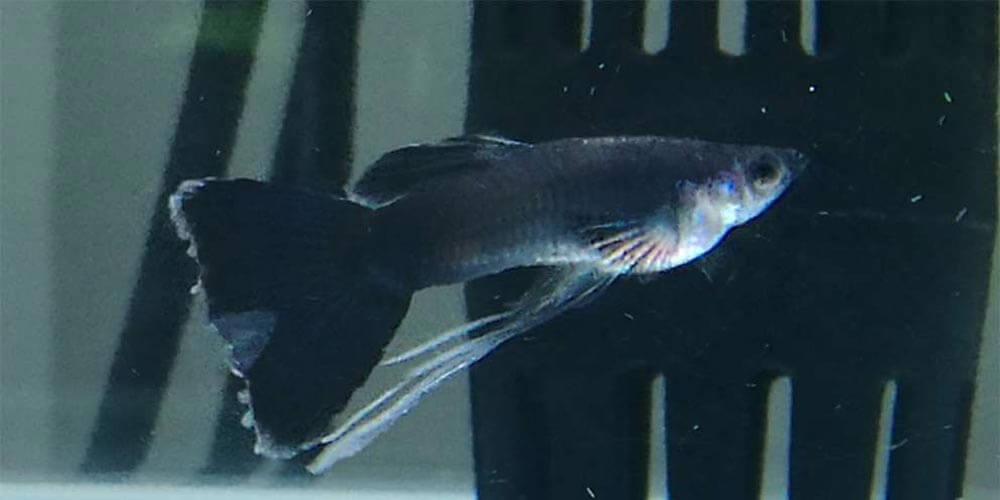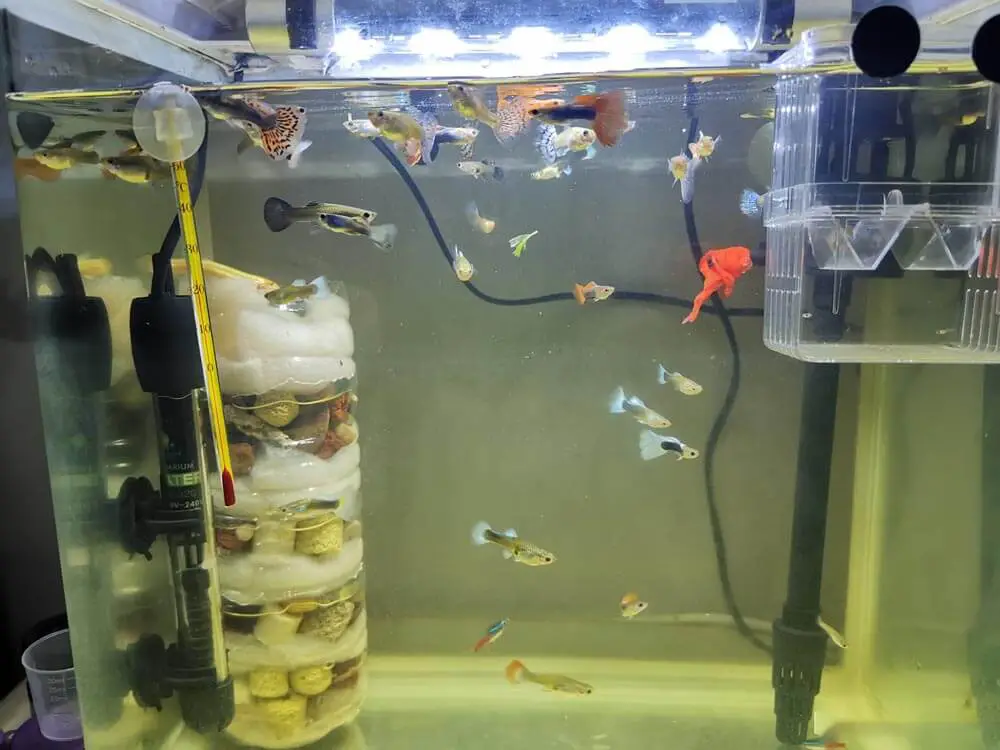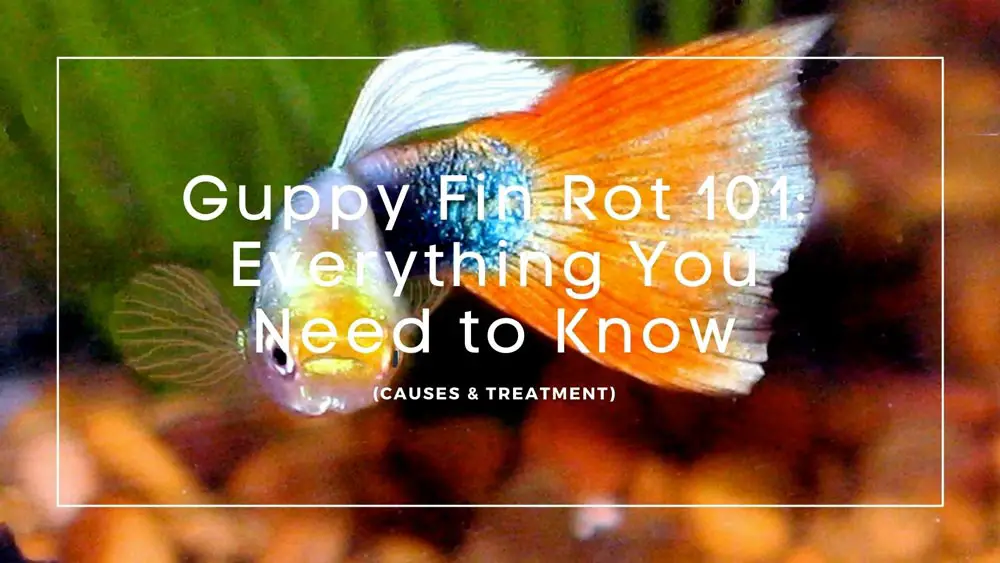Guppy fin rot is a common and treatable disease that affects a variety of fish, not just guppies! If you spot and treat it early enough, your fish can fully recover and return to a happy state, but if you don’t know your fish has it or you leave it untreated, it can be deadly.
Keep reading this guide to learn all about guppy fin rot, how to treat it, and how to prevent it from returning in the future.
What is Guppy Fin Rot, and What Are the Causes?
Guppy fin rot is a disease that can affect a number of aquarium fish species, but it’s most common among fish like Betta‘s that have long flowing tails. It can be both a fungal or bacterial infection that is caused by poor water quality or a stressful environment for your fish.
What Are The Symptoms Of Guppy Fin Rot?
Fortunately, fin rot in guppies is pretty easy to spot, especially if you’re checking for symptoms regularly. However, it’s important to be able to spot all the different symptoms so you can figure out how serious the fin rot is, as well as whether it’s bacterial or fungal.
There are three levels of severity when it comes to fin rot: Mild, Major, and Severe. Each level has its own set of symptoms, but in general, it’s relatively easy to spot fin rot in your fish if you’re taking the time to inspect them. As a fish owner, knowing the symptoms is essential, so you can identify the severity and whether it’s bacterial or fungal.
Depending on which type of fin rot your fish is plagued with, they may need a different treatment.
Bacterial vs Fungal Guppy Fin Rot
Bacterial fin rot causes the fins to look ragged and uneven. Fungal fin rot causes the fins to develop a white edge along the edge of the fins, and the fins appear more even, as opposed to bacterial infections. If you notice white spots, it could be ich instead of fin rot. Sometimes, both types of infection are seen together.
Mild Guppy Tail Rot Symptoms and Treatment

If you catch mild Guppy fin rot early, then there’s a good chance your fish can make a full recovery. The symptoms of this level of infection are usually very minor and may only include some redness or inflammation around the edge of the fins.
Symptoms of Mild Fin Rot in Guppy Fish
- Signs of irritation
- The fins look sore and red
- The tips of the fins may change color to be darker, brown, white, or grey
- It is localized to the tips of the fins
- The edges of the fins may begin to look tattered, but it won’t be severe at a mild stage
How To Treat Mild Fin Rot In Guppies:
When fin rot is in the mild stages, it’s much easier to treat than major or severe. Here’s how you should go about treating mild guppy fish fin rot.
- Firstly, cleaning the gravel at the bottom of the tank is vital. Removing any waste or debris will immediately help the situation because they feed bacteria that is causing the fin rot to occur.
- Once the tank’s bottom is cleaned out, do a 25% water change, replacing the old water with fresh and clean water.
- Check your water parameters to ensure they’re all where they should be. Check the pH balance, chlorine, nitrite, temperature, nitrate, and ammonia levels. You can easily pick up a testing kit from your local pet store or purchase one online.
- Once you’ve ensured the environment is clean and ideal, you can begin to treat your fish. When it comes to minor fin rot, an API Stress Coat or aquarium conditioner typically does the trick.
- Follow the label and manufacturer-specified instructions until the guppy fish fin rot starts to clear up.
- It’s crucial that you remove the carbon filter in the quarantine tank, as it can have a negative impact on the treatment’s effectiveness.
- Keep a close watch on your fish to ensure they’re improving and returning to their optimal health.
Major Fin Rot Symptoms and Treatment In Guppies

You’ve been looking after your guppies for a long time and you know that they are worth the effort, but if their fin rot is getting out of control then don’t waste another second. This condition can be fatal and open up the possibility to many illnesses or diseases.
Symptoms of Major Fin Rot in Guppy Fish
- Fins are now discolored, likely darkened
- Significant parts of the fin may be rotted away
- Fins are starting to die completely
- If it’s a fungal infection, the fins will have white fuzz along the edges
- Chunks of the fin may be falling off in the tank
How To Treat Major Fin Rot In Guppies:
If you’ve missed the initial symptoms of mild fin rot, your fish will likely become more ill, and the severity will increase to major fin rot. Once this has occurred, your treatment plan will be a bit different. Major fin rot will need to be cared for as soon as possible to prevent further infection.
- Upon recognizing that your guppy fish has fin rot, you will need to set up a separate quarantine tank for them. Acclimatize them by using water from the old tank.
- Once you have the aquarium fish settled in the main tank, you will need to perform a complete water change and clean all the surfaces that you can. This will help prevent the fin rot from returning and prevent tank mates from getting infected as well.
- Mix water and aquarium salt and let it dissolve. Once it’s completely dissolved, you can add it to the quarantine tank. Please follow the manufactures instructions for the amount you should use.
- While using aquarium salt, you will be required to change the water altogether each day. Ensure you don’t put more than the recommended amount in more than once in the water.
- The aquarium salt will tell you the recommended amount of time to do this for, which is typically around a week.
Severe Fin Rot Symptoms and Treatment In Guppies
If fin rot is left untreated for a couple of weeks, it can develop into severe fin rot or body rot. Severe fin rot is considered extreme, and it’s difficult to save your fish at this time due to the progression of the infection.
Symptoms of Severe Fin Rot in Guppy Fish
- Fins are entirely eaten away and decayed
- The body of your fish has started to rot
- If it’s a fungal infection, there may be white fuzz along the area where the fins previously were
- Your fish is lethargic
- Loss of appetite
How To Treat Severe Fin Rot In Guppies:
Once your fish has reached the severe fin rot stage, it’s likely they won’t survive the infection. Treatment is much more intense to try and save your fish once they get body rot. If it’s fungal, you will require a strong medication, like API Pimafix, and if it’s bacterial infection, you’ll need API Furan 2.
- Firstly, you will need to set up a quarantine tank for your fish, but you will require an air bubbler this time. Some of the medications to treat severe fin rot also impede the tank’s oxygen levels, so an air bubbler will help keep the water oxygenated.
- Once your fish is settled in the new tank, you can begin providing medication, depending on which type of infection they have.
- Ensure you are performing 100% water changes before providing more medication, as they can become poisoned.
- Clean out your other tank thoroughly and replace the water 100% with fresh water.
- Inspect your other fish to ensure the infection has not impacted them.
- Once your fish is showing improvements, and the medication cycle is done, you can reintroduce them into your original tank.

As the severity of the fin rot increases, the treatment for your fish becomes more extreme. Each level of severity has its own set of treatments, and depending on whether it’s bacterial or fungal will make a difference as well. If you notice something is wrong in the early stages, treatment is easier and more effective.
If you’re dealing with major or severe fin rot, your fish will have a more challenging time making a full recovery. When you notice issues with your fish, it’s always recommended to seek the advice of a trusted professional who can help you get your fish back to optimal health.
When you begin to treat fin rot, you will want to create a quarantine tank for your infected fish. This helps prevent the spread of fin rot to their tank mates but allows the treatment to be effective for your one fish and not all of them.
As mentioned, fin rot can also be caused by stress, so if the fish has been bullied, putting them in a separate tank prevents fin nipping.
To learn more about how to care for guppies then check out this article.
How to Prevent Fin Rot In Guppies?
Prevention is critical when it comes to common guppy diseases and infections, and thankfully preventing fin rot is reasonably straightforward. Here are ways to prevent fin rot.
Regular Tank Cleanings
Cleaning your tank regularly prevents a whole host of problems that can affect your fish. Depending on the size of your tank and how many fish you have, you will need to find out a cleaning schedule that works for you. The bigger the tank and the more fish means that you need to clean the tank more often.
Don’t Overfill Your Tank
Overcrowding is one of the most important ways to prevent fin rot. It increases the risk of infection because of the increased bioload from all the different fish. It also causes unnecessary stress on your fish when you continue to introduce new tank mates without increasing the size of your tank. The more fish you have, the more likely some will become aggressive, which can cause fin nipping.
Change Water Regularly
Much like cleaning your tank often, you’ll want to ensure you’re performing water changes. The size will impact how often you need to do this. Tanks that are smaller may require water changes every three or four days, while larger tanks may require changing every other week.

Use a Quality Filter
Filters are critical when trying to keep your tank clean, as it is constantly filtering out excess debris, ammonia, and waste, which can all cause sickness in fish. Many fish owners try to get away without having a filter when they own guppies, but it’s always recommended to have a quality filter in any fish tank, regardless of size or fish types.
Provide a High Quality Food
Feeding your fish should include a high-quality diet and the best food you can. Providing them with adequate nutrition is critical, helping boost their immune system, so they can fight off any potential infections that may be introduced to the fish tank. Most fish need a combination of plant matter and meat, and you can give them live food treats every so often.
(Not sure what is the high quality food for guppies? Check out our top picks)
If you Have any Bullies, Remove Them
When fish start to become aggressive, they can become relentless. Any bullies need to be removed as soon as you notice that it’s happening. The more bullying that takes place means the risk for sickness dramatically increases.
If you don’t have a separate tank for a fish that is aggressive, you can try to return them to the pet shop that you got them. If these are not ideal for you, you can provide your fish with some extra hiding spots and try to manage as best you can.
How Contagious is Fin Rot to Tank Mates?
Thankfully, fin rot is not very contagious, but that shouldn’t stop you from acting quickly to prevent fin rot from spreading. Especially if your infected fish moves beyond mild fish rot, it can end up affecting your entire tank.
Suppose you discover one of your fish has developed fin rot. In that case, you must deep clean your tank and perform a 100% water change to ensure that it does not spread, and do not reintroduce your infected fish until they are entirely better.
By keeping a close eye on your fish and visually inspecting them often, you can feel confident that you’ll catch any fin rot before it becomes a massive problem.
You May Also Like: Guppy Fish 101: Types, Care, Lifespan, Breeding And Tank Mates
Conclusion
Guppy fin rot can happen to the best of fish owners, but it’s essential to treat it as soon as you can to give your fish the best fighting chance. Now that you’re prepared with the knowledge of what it looks like, the symptoms, how to prevent it and how to treat fin rot, you can effectively keep your fish happy and healthy.
The best thing you can do for your fish is keeping their environment clean and healthy, ensuring you’re not overstocking your tank, and visually inspecting them often.





